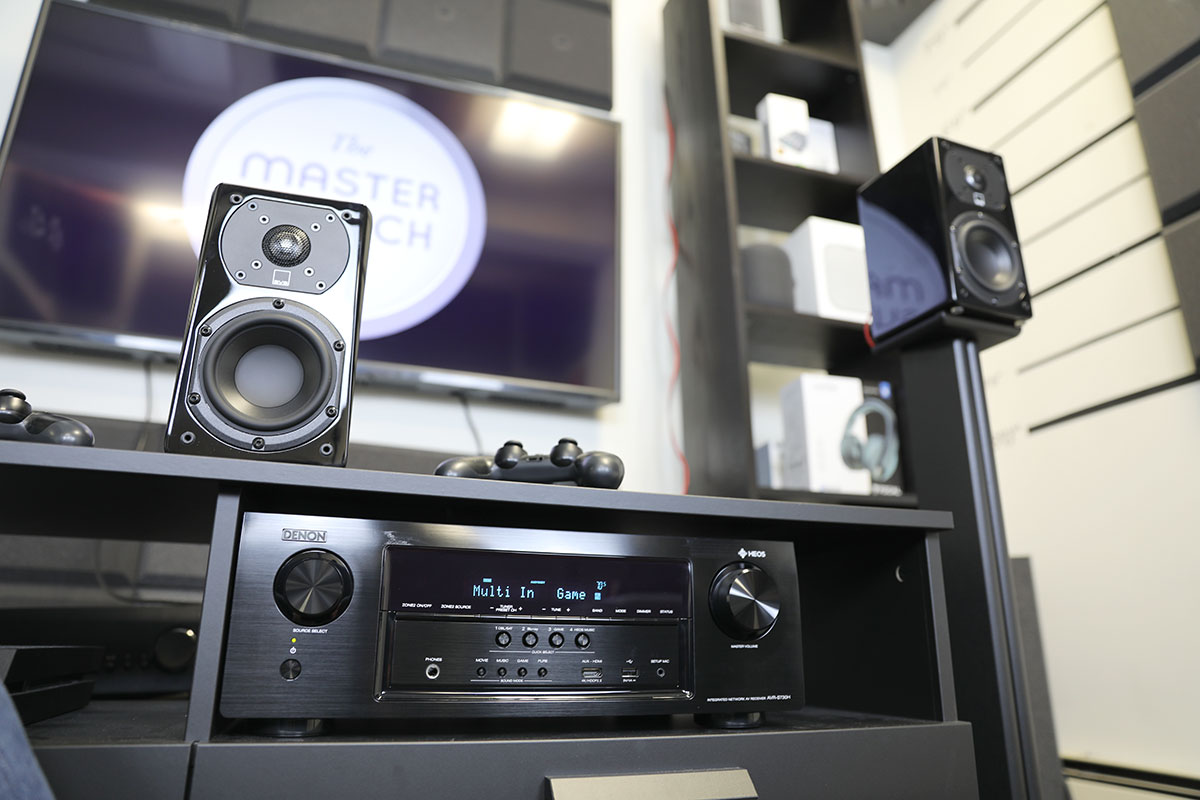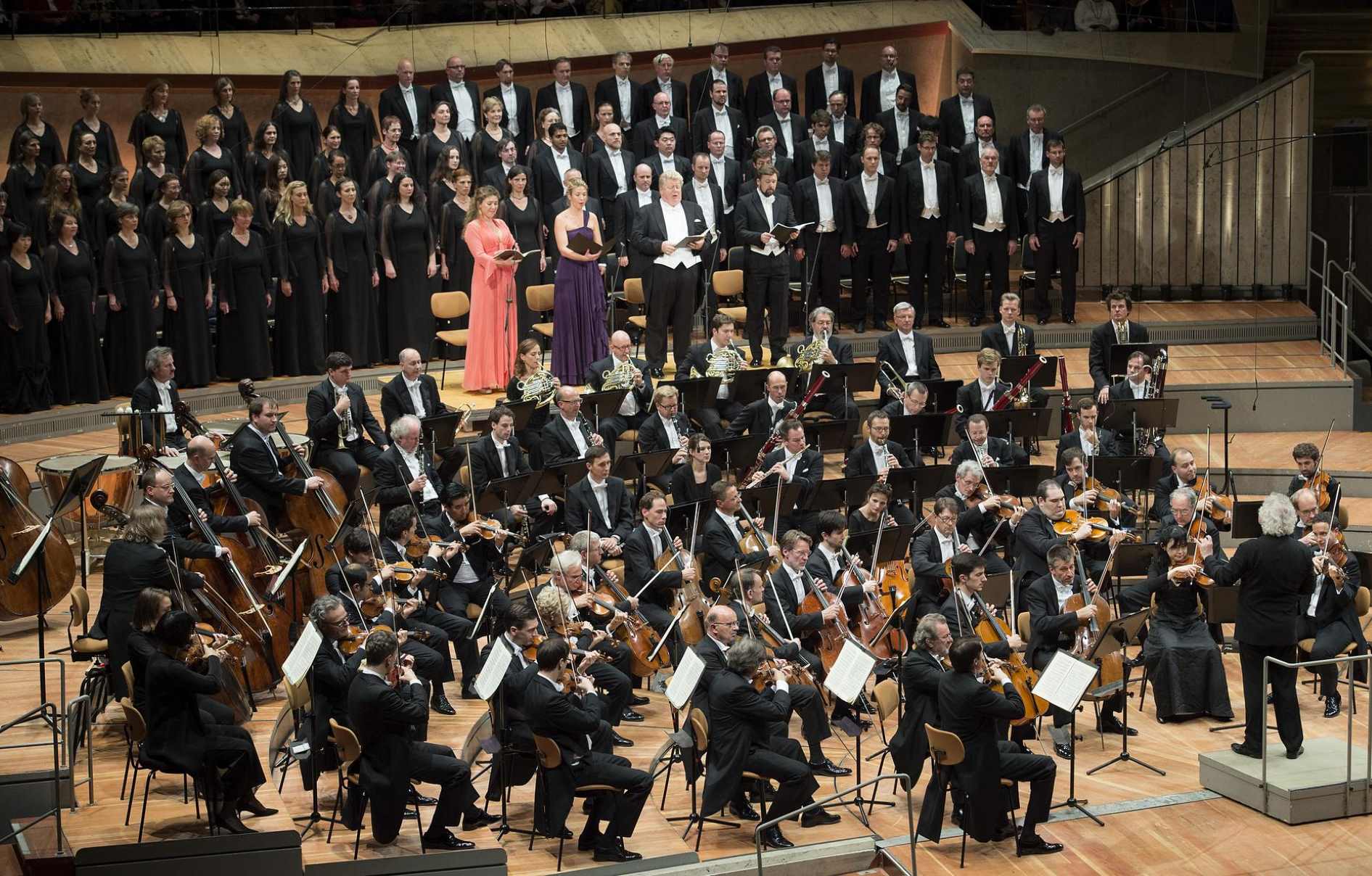Home>Production & Technology>Stereo>What Is The Difference Between Surround Sound And Stereo


Stereo
What Is The Difference Between Surround Sound And Stereo
Modified: January 22, 2024
Discover the distinction between surround sound and stereo systems and learn how stereo enhances your audio experience. Find out more about stereo technology.
(Many of the links in this article redirect to a specific reviewed product. Your purchase of these products through affiliate links helps to generate commission for AudioLover.com, at no extra cost. Learn more)
Table of Contents
- Introduction
- Definition of Surround Sound
- Definition of Stereo
- Audio Channels in Surround Sound
- Audio Channels in Stereo
- Speaker Setup in Surround Sound
- Speaker Setup in Stereo
- Sound Localization in Surround Sound
- Sound Localization in Stereo
- Benefits of Surround Sound
- Benefits of Stereo
- Popular Uses of Surround Sound
- Popular Uses of Stereo
- Conclusion
Introduction
Welcome to the world of audio immersion! When it comes to creating a captivating sound experience, two terms that often come up are “surround sound” and “stereo.” Whether you’re shopping for speakers, setting up a home theater system, or simply curious about audio technology, understanding the difference between these two formats is essential.
Surround sound and stereo are two distinct methods of audio reproduction, each with its own unique characteristics and applications. While both deliver high-quality sound, they approach audio reproduction in different ways, resulting in varying experiences for the listener.
In this article, we’ll delve into the world of surround sound and stereo, exploring the definitions, speaker setups, sound localization, benefits, and popular uses of each. By the end, you’ll have a clear understanding of these two formats and be able to make informed decisions when it comes to your audio needs.
So let’s dive in and unravel the differences between surround sound and stereo, and discover how they shape our audio experiences!
Definition of Surround Sound
Surround sound is a method of audio reproduction that aims to create a three-dimensional sound experience for the listener. It uses multiple audio channels and speakers strategically placed around the listening area to immerse the audience in sound from all directions.
The most common format for surround sound is 5.1, which consists of five main speakers and one subwoofer. The main speakers are positioned in a configuration that includes a center speaker, two front speakers, and two surround speakers placed behind the listener. The subwoofer is responsible for handling low-frequency sounds, adding depth and impact to the overall audio experience.
In addition to the 5.1 setup, there are more advanced formats such as 7.1 and Dolby Atmos, which utilize additional speakers to further enhance the surround sound effect. These formats provide even more precise sound localization and create a more realistic and immersive audio experience.
Surround sound is commonly used in home theater systems, gaming setups, and cinema environments. It brings movies, TV shows, and video games to life by enveloping the viewer in a rich and dynamic audio environment. With surround sound, you can feel like you’re in the middle of the action, as sounds are accurately placed around you, creating a more immersive and engaging experience.
Moreover, surround sound is not limited to entertainment purposes. It is also utilized in professional audio production, such as music mixing and sound design for films. By being able to precisely place sounds in the audio field, audio professionals can create a more realistic and immersive listening experience for their audience.
Overall, surround sound creates a sense of depth and realism by utilizing multiple speakers and audio channels to envelop the listener in a three-dimensional sound environment. It enhances the overall audio experience and adds a new level of immersion and excitement to various forms of media and entertainment.
Definition of Stereo
Stereo, short for stereophonic sound, is a method of audio reproduction that aims to create a realistic and natural sound experience for the listener. Unlike surround sound, which uses multiple speakers to create a multidirectional effect, stereo relies on two speakers to convey a sense of depth and spatial separation.
In a stereo audio setup, there are two main speakers, commonly referred to as the left and right channels. The left speaker reproduces the audio signals intended for the left side of the soundstage, while the right speaker handles the audio signals intended for the right side. By distributing the sound between these two channels, stereo creates a sense of width and space.
Stereo audio is typically reproduced using a 2.0 speaker system, which consists of two speakers without any additional subwoofers or surround sound speakers. The sound signals are mixed and mastered in a way that the listener perceives a balanced and natural representation of the audio, with instruments and vocals positioned in a virtual soundstage.
One of the key benefits of stereo sound is its simplicity and versatility. It is widely used in music playback systems, where it allows for accurate reproduction and spatial separation of instruments and vocals. Stereo sound brings depth and clarity to music, creating an immersive and enjoyable listening experience.
In addition to music playback, stereo is also utilized in various other applications such as radio broadcasts, podcasts, and audio production. It provides a practical and effective way of delivering clear and balanced audio in a wide range of contexts.
While stereo may not offer the same level of surround sound immersion, it remains a popular choice for many audio enthusiasts due to its simplicity, affordability, and widespread compatibility. From enjoying music at home to listening to podcasts on the go, stereo sound continues to be a reliable and effective method of audio reproduction.
In summary, stereo sound utilizes two main speakers to create a realistic and natural audio experience. It offers spatial separation and a sense of depth in audio playback, making it a popular choice for music enthusiasts, radio broadcasts, and various other audio applications.
Audio Channels in Surround Sound
Surround sound employs multiple audio channels to create a captivating and immersive audio experience. Each audio channel carries a specific part of the audio signal, contributing to the overall soundstage and localization of sound. The most common format for surround sound is 5.1, which consists of six audio channels:
- Front Left and Right: These channels reproduce sound from the front-left and front-right speakers, creating the basis of the stereo image. They handle most of the music, dialogue, and sound effects.
- Center: The center channel is dedicated to reproducing dialogue and other on-screen sounds. It helps anchor the audio in the center of the soundstage, ensuring clear and intelligible speech.
- Surround Left and Right: Positioned behind the listener, these channels create a sense of envelopment. They enhance the three-dimensional aspect of surround sound by delivering ambient sounds, surround effects, and sound effects that originate from behind or to the sides of the listener.
- Subwoofer/LFE: The subwoofer channel handles low-frequency sounds, such as deep bass and rumbling effects, adding impact and intensity to the audio experience. It provides the foundation for powerful and immersive sound reproduction.
Additional audio channels can be added to the surround sound setup for more advanced formats, such as 7.1 or Dolby Atmos. These setups introduce further speakers, such as rear surround speakers and overhead speakers, to enhance the spatial accuracy and immersion of the audio experience.
The use of multiple audio channels in surround sound allows for precise sound positioning and movement. By distributing sounds across different speakers, it creates a sense of directionality, depth, and realism. When properly set up and calibrated, surround sound systems can make the listener feel like they are in the middle of the action, placing them at the center of a rich and dynamic sound environment.
Overall, the use of multiple audio channels in surround sound helps to create an immersive and realistic audio experience, with each channel playing a specific role in delivering an engaging and lifelike sound presentation.
Audio Channels in Stereo
Stereo sound, as the name suggests, utilizes two audio channels to create a rich and immersive audio experience. These two channels are commonly referred to as the left and right channels. Each channel carries a different part of the audio signal, contributing to the stereo imaging and spatial separation of sound.
The left channel is responsible for reproducing the audio intended for the left side of the sound field, while the right channel handles the audio signals intended for the right side. By distributing the sound between these two channels, stereo sound creates a sense of width and depth, enhancing the listener’s perception of the soundstage.
The two audio channels work together to recreate a natural and realistic audio experience, allowing for the spatial positioning of sound sources. Instruments and vocals are typically mixed and mastered in a way that they are panned or positioned within the stereo field, providing a sense of dimension and separation.
Stereo sound is commonly represented using a 2.0 configuration, where “2” denotes the two audio channels and “0” indicates the absence of additional channels, such as a center channel or subwoofer. This setup is widely used in music playback systems, as well as other audio applications.
With stereo sound, listeners can enjoy an accurate representation of music, where instruments and vocals are spread across the soundstage. The left and right channels work together to create a balanced and immersive listening experience, allowing for a more engaging and enjoyable enjoyment of audio content.
While stereo sound does not provide the same level of surround sound immersion, it remains a popular choice for many audio enthusiasts due to its simplicity and versatility. It is compatible with a wide range of audio sources and playback devices, making it accessible and widely used across various contexts.
In summary, stereo sound utilizes two audio channels to create a sense of width, depth, and spatial separation in audio playback. The left and right channels work together to recreate an immersive and natural listening experience, making stereo sound a popular choice for music enthusiasts and everyday audio applications.
Speaker Setup in Surround Sound
The speaker setup in surround sound systems is crucial in delivering an immersive and realistic audio experience. It involves strategically placing multiple speakers around the listening area to create a three-dimensional sound environment. The most common speaker configuration in surround sound is the 5.1 setup, consisting of six speakers:
- Center Speaker: This speaker is placed above or below the display screen, typically at the same height as the listener’s ears. Its primary role is to reproduce dialogue and on-screen sound, ensuring clear and intelligible speech.
- Front Left and Right Speakers: These speakers are positioned on either side of the display screen, facing the listener. They handle most of the music, sound effects, and non-diegetic sounds, creating a stereo imaging and serving as the primary audio source.
- Surround Left and Right Speakers: These speakers are placed to the sides or slightly behind the listening area, creating a sense of envelopment and expanding the soundstage. They are responsible for reproducing ambient sounds, surround effects, and sound effects that originate from behind or to the sides of the listener.
- Subwoofer/LFE: The subwoofer, also known as the Low-Frequency Effects (LFE) channel, is responsible for handling low-frequency sounds such as deep bass and rumbling effects. It is placed in a position that offers the most effective low-frequency distribution throughout the room.
In more advanced surround sound setups, such as 7.1 or Dolby Atmos, additional speakers may be added. 7.1 setups introduce rear surround speakers, placed behind the listener, to further enhance the envelopment of sound. Dolby Atmos setups incorporate speakers positioned overhead or ceiling-mounted for a more immersive audio experience with object-based sound placement.
The precise placement of the speakers is essential for optimal sound reproduction. It is recommended to follow industry best practices and guidelines, taking into consideration factors such as listener position, room acoustics, and speaker specifications. Proper speaker setup ensures accurate sound localization, proper distribution of sound effects, and a well-balanced audio presentation.
Overall, the speaker setup in surround sound systems plays a significant role in creating an immersive and realistic audio experience. By strategically placing speakers around the listening area, surround sound systems deliver a captivating sound environment that immerses the listener in a three-dimensional auditory experience.
Speaker Setup in Stereo
The speaker setup in stereo systems is relatively straightforward, as it involves using two speakers to create a rich and immersive audio experience. These two speakers, commonly referred to as the left and right channels, are placed in a configuration that allows for optimal sound reproduction and stereo imaging.
In a stereo setup, the ideal placement of the speakers is to have them positioned equidistant from the listening area, forming an equilateral triangle with the listener. The speakers should face the listener directly to ensure an accurate stereo image and proper soundstage depth.
When setting up the speakers, it is important to consider factors such as the room acoustics and the listener’s position. The speakers should be positioned at a height that aligns with the listener’s ears for optimal sound projection. Additionally, it is recommended to have some space between the speakers and the walls or other objects to minimize sound reflections and interference.
While the standard stereo setup consists of two main speakers, there are variations such as bookshelf, floor-standing, or monitor speakers that can be used based on personal preference and room size. These speakers are designed to deliver a wide frequency range and accurate sound reproduction, ensuring a high-quality stereo listening experience.
Additionally, some stereo setups may include a subwoofer to enhance the low-frequency response, especially for music genres that emphasize bass characteristics. The subwoofer can be positioned anywhere in the room, as low-frequency sounds are less directional and can provide a fuller and more impactful audio experience.
Proper speaker setup in stereo systems is essential for achieving accurate sound reproduction and creating a realistic soundstage. By placing the speakers at optimal positions and considering factors such as listener position and room acoustics, stereo systems provide a balanced and immersive audio experience.
It’s worth noting that stereo systems can also benefit from careful room treatment and acoustic optimization to further enhance the overall sound quality. Room acoustic treatments can help reduce unwanted reflections, standing waves, and echoes, resulting in a more accurate and enjoyable listening experience.
In summary, stereo speaker setups involve using two speakers placed in an optimal configuration to create a wide and immersive audio experience. By strategically positioning the speakers and considering room acoustics, stereo systems deliver accurate sound reproduction and a captivating listening experience.
Sound Localization in Surround Sound
One of the key features of surround sound systems is their ability to accurately localize sound sources, creating a three-dimensional audio experience. Sound localization refers to the listener’s perception of where sounds are originating from within the surround sound setup.
In surround sound systems, the placement of speakers around the listening area is crucial for achieving precise sound localization. By strategically positioning the speakers, audio engineers and designers aim to recreate a realistic and immersive sound environment where listeners can identify the direction from which sounds are coming.
The front left and right speakers in a surround sound system play a crucial role in stereo imaging and soundstage depth. They deliver sound signals intended for the left and right channels, which allows the listener to perceive sound originating from different directions. For example, if an object is supposed to be on the left side of the screen, the sound will be predominantly reproduced by the left speaker, enhancing the sense of directionality and realism.
The center speaker in the surround sound setup ensures that dialogues and on-screen sounds are accurately reproduced and localized. Placed above or below the display screen, the center speaker helps anchor the sound in the center of the soundstage, ensuring clear and intelligible speech coming directly from the screen.
The surround left and right speakers in a surround sound system are responsible for reproducing ambient sounds, surround effects, and sound effects that originate from behind or to the sides of the listener. By having dedicated surround speakers placed at appropriate angles to the listening position, the system can create a sense of envelopment and enhance spatial accuracy.
Additionally, advanced surround sound setups, such as 7.1 or Dolby Atmos, introduce rear surround speakers and overhead speakers, respectively. These additional speakers further enhance sound localization by expanding the sound field and allowing for more precise positioning of sound sources.
When properly set up and calibrated, a surround sound system creates a realistic and immersive audio environment. Sounds can be accurately localized, giving the listener a sense of depth, spatial separation, and directionality. By distributing sound across multiple speakers, surround sound systems enhance the overall audio experience and transport the listener into the world of the content being played.
Sound localization in surround sound systems adds another layer of realism and immersion to various forms of media and entertainment. Whether it’s a thrilling movie scene, a video game with immersive sound effects, or a concert recording, surround sound systems truly bring the audio to life with their accurate sound localization capabilities.
Sound Localization in Stereo
Sound localization in stereo systems refers to the listener’s ability to identify the position of sound sources within the stereo field. While stereo sound doesn’t provide the same level of spatial accuracy as surround sound, it can still create a convincing illusion of sound placement when properly set up.
In a stereo setup, sound localization is achieved through the use of two speakers – the left and right channels. Each channel carries a different part of the audio signal and is responsible for creating a sense of width and separation within the stereo field.
When sounds are mixed and mastered for stereo playback, audio engineers and producers create a sonic image that presents audio sources as being positioned within the soundstage. By panning elements in the stereo mix, such as instruments or vocals, the listener can perceive their placement to the left, right, or center of the sound field.
Listeners can develop spatial awareness by picking up on subtle cues in the stereo mix, such as differences in volume, timing, and frequency content between the left and right channels. These cues help create a sense of directionality, allowing the listener to perceive the relative position of sound sources within the stereo image.
Placement within the stereo field can be further enhanced through stereo imaging techniques, such as the use of reverberation, delay effects, and stereo widening. These techniques create a sense of depth, spaciousness, and width, amplifying the listener’s perception of sound placement.
While stereo systems don’t offer the same level of immersive sound localization as surround sound, they still provide an enjoyable listening experience with accurate panning and stereo imaging. With a well-calibrated system and optimal speaker placement, stereo systems can genuinely recreate a convincing stereo image that enhances the overall audio experience.
It’s important to note that the effectiveness of sound localization in stereo systems largely depends on the listener’s position relative to the speakers and the room’s acoustics. Sitting at an optimal listening position and minimizing room reflections can help improve the accuracy of sound placement within the stereo field.
In summary, while stereo systems may not provide the same level of precise sound localization as surround sound setups, they can still create an immersive and enjoyable audio experience. Through careful mixing, panning, and stereo imaging techniques, stereo systems present sound sources within the stereo field, allowing listeners to perceive their relative positions and enjoy a rich and dynamic audio presentation.
Benefits of Surround Sound
Surround sound systems offer a range of benefits that enhance the overall audio experience and bring entertainment to life. Let’s explore some of the key advantages of incorporating surround sound into your audio setup:
- Immersive Audio Experience: Surround sound systems create a three-dimensional sound environment, immersing the listener in a lifelike audio experience. With sounds coming from multiple directions, surround sound envelopes the listener, making them feel fully immersed in the content being played.
- Enhanced Sound Localization: Surround sound systems excel at accurate sound localization, allowing for precise positioning of audio sources within the soundstage. This adds depth, realism, and a heightened sense of immersion, making the audio experience more engaging and lifelike.
- Spacious Soundstage: By distributing sound across multiple speakers, surround sound systems create a wide and spacious soundstage. This provides a sense of space, allowing audio to be presented with depth, width, and separation, bringing a new level of realism to movies, music, and games.
- Impactful Low-Frequency Effects: With the dedicated subwoofer channel, surround sound systems deliver powerful and impactful low-frequency effects. The subwoofer reproduces deep bass and rumbling sounds, adding intensity and realism to explosions, musical scores, and action sequences.
- Multi-Channel Audio Content: Many movies, TV shows, and video games are encoded with surround sound audio tracks. With a surround sound system, you can fully appreciate the intent of the content creators, enjoying the audio as it was originally designed to be experienced.
- Music Listening Experience: Surround sound systems are not limited to movies and games; they can also enhance the music listening experience. With multi-channel music mixes and concert recordings, surround sound systems bring a concert-like atmosphere into your living room, adding depth and spatial separation to the music.
- Home Theater Entertainment: Surround sound systems are an integral part of home theater setups. They transform watching movies and TV shows into a cinematic experience, with audio that matches the stunning visuals. The combination of surround sound and a large-screen display truly brings the theater experience home.
- Professional Audio Production: Surround sound systems are not just for entertainment purposes. They are also utilized in professional audio production, including film sound design and music mixing. Audio professionals rely on surround sound systems to accurately position and mix sounds, creating captivating and immersive audio for various media.
In summary, surround sound systems provide an immersive and realistic audio experience, enhancing the enjoyment of movies, music, and games. From accurate sound localization to impactful low-frequency effects, the benefits of surround sound systems bring a new level of depth, realism, and immersion to audio content, truly enriching the overall listening experience.
Benefits of Stereo
Stereo sound, with its simplicity and versatility, offers several benefits that enhance the audio experience across various contexts. Let’s explore some of the key advantages of incorporating stereo sound into your setup:
- Natural Sound Reproduction: Stereo systems aim to recreate a natural and realistic audio experience. By using two speakers to deliver sound from different directions, stereo sound provides a sense of width and spatial separation, simulating the way we naturally hear sound in the real world.
- Music Enjoyment: Stereo is renowned for its ability to reproduce music with clarity, depth, and detail. It offers a balanced audio presentation, allowing for accurate panning of instruments and vocals, which enhances the immersion and enjoyment of music across various genres.
- Simplicity and Affordability: Stereo setups are generally more straightforward and cost-effective than surround sound systems. With only two speakers, they require less setup and typically come at a lower price point, making stereo a suitable option for those with limited space or budget.
- Compatibility and Accessibility: Stereo sound is compatible with a wide range of audio sources and playback devices, including smartphones, computers, and home stereo systems. It is a universally accessible format, ensuring that stereo content can be enjoyed across different platforms and devices.
- Podcasts and Audio Content: For podcasts, radio broadcasts, and audiobooks, stereo sound provides an immersive and engaging listening experience. The separation of voices and audio elements between the left and right channels allows for better comprehension and enjoyment of spoken content.
- Everyday Audio Applications: Stereo sound is not limited to entertainment purposes. It is widely used in everyday audio applications such as phone calls, video conferences, and voice recordings. Stereo microphones and speakers offer improved clarity and spatial accuracy in these communication scenarios.
- Proximity Effect: Stereo systems provide a proximity effect, which is particularly beneficial for solo instruments and vocals. By positioning the audio source closer to one speaker, stereo sound amplifies the sense of closeness and intimacy, adding a natural dynamic to the audio presentation.
- Portability: Stereo sound can be experienced on the go through portable audio devices such as headphones and earphones. This allows for a personal and immersive audio experience, whether you’re listening to music, podcasts, or watching movies on a portable device.
In summary, stereo sound offers a natural and immersive audio experience, particularly well-suited for music enjoyment, podcasts, and everyday audio applications. With its simplicity, affordability, and widespread compatibility, stereo provides a versatile and accessible option for enhancing the audio experience across various settings and devices.
Popular Uses of Surround Sound
Surround sound systems have gained significant popularity in various settings due to their ability to create an immersive and captivating audio experience. Let’s explore some of the popular uses of surround sound:
- Home Theaters: One of the most common and popular uses of surround sound is in home theater setups. By combining a high-quality surround sound system with a large-screen display, viewers can enjoy a cinema-like experience in the comfort of their own homes. Surround sound systems bring movies, TV shows, and streaming content to life, enhancing the audio and immersing the viewer in a captivating audiovisual experience.
- Gaming: Surround sound plays a crucial role in gaming, adding depth, realism, and immersion to gameplay. By accurately positioning sound effects, ambient noises, and character dialogue, surround sound systems enable gamers to have a more spatially aware and engaging gaming experience. Players can precisely locate the source of sounds, providing a competitive advantage and enhancing their overall enjoyment of the game.
- Music Production: Surround sound is also utilized in professional music production and mixing. Artists and producers can experiment with multi-channel audio setups to enhance the spatial characteristics of their music. Surround sound systems provide a wider soundstage, allowing for precise panning of instruments and vocals, resulting in a more immersive and dynamic music listening experience.
- Virtual Reality (VR): Surround sound is an integral component of virtual reality experiences. It adds another layer of immersion to VR environments by accurately placing sounds in different directions, synchronized with the visual elements. Whether it’s exploring virtual worlds, playing immersive VR games, or watching 360-degree videos, surround sound systems heighten the sense of presence and realism, making the virtual experience more lifelike.
- Cinemas and Theaters: Commercial cinemas and theaters have long employed surround sound technology to create a captivating audio experience for moviegoers. By utilizing advanced surround sound formats such as Dolby Atmos, theaters deliver rich, multidirectional soundscapes, enhancing the cinematic experience and creating an immersive environment for films and live performances.
- Live Events and Concerts: Surround sound systems are utilized in live events and concerts to provide an enhanced and immersive audio experience for the audience. By deploying surround sound speakers strategically throughout the venue, concertgoers can feel like they’re in the middle of the performance, with the music surrounding them from all directions, adding depth and realism to the live performance.
- Audiovisual Installations: Surround sound systems find applications in various audiovisual installations, such as museums, art installations, theme parks, and interactive exhibits. By creating a three-dimensional soundscape, surround sound technology adds an extra layer of immersion and engagement to these installations, enhancing the overall visitor experience.
With its ability to create an immersive and realistic audio experience, surround sound systems have become popular across a wide range of settings. From home theaters and gaming setups to music production and commercial venues, surround sound technology plays a crucial role in delivering captivating audio experiences in various forms of media and entertainment.
Popular Uses of Stereo
Stereo sound has become a ubiquitous and popular audio format that is utilized in a variety of settings and applications. Let’s explore some of the common and popular uses of stereo sound:
- Music Playback: Stereo is widely used for music listening and enjoyment. Whether it’s playing your favorite albums at home or enjoying music on the go, stereo sound provides a balanced and immersive audio experience. It allows for accurate sound reproduction, spatial separation of instruments and vocals, and a wide soundstage, enhancing the listener’s enjoyment and appreciation of music.
- Podcasts and Radio Broadcasting: Stereo sound is commonly used in podcasting and radio broadcasting. It enables hosts and content creators to deliver their voices and audio elements with clarity and spatial separation, enhancing the listener’s comprehension and engagement. By using stereo microphones and speakers, podcasts and radio shows can create a more immersive and engaging listening experience.
- Computer Audio: Stereo sound is a standard audio format for computer systems. Whether it’s watching videos, playing games, or listening to music on your computer, stereo sound provides an enjoyable audio experience. It allows for accurate sound positioning and spatial separation, enhancing the immersion and engagement of various forms of computer content.
- Mobile Devices and Headphones: Stereo sound is prevalent on mobile devices such as smartphones and tablets. It allows users to enjoy music, podcasts, and other audio content with enhanced depth and separation. Coupled with headphones or earphones, stereo sound provides a personal and immersive audio experience, allowing users to enjoy high-quality audio wherever they go.
- Television Broadcasting and Streaming: Stereo sound is widely used in television broadcasting and streaming services. It ensures that viewers can enjoy TV shows, movies, and streaming content with clear dialogue, accurate sound effects, and enhanced immersion. Stereo sound enhances the audio aspect of the visual content, creating a more engaging and immersive viewing experience.
- Music Production and Mixing: Stereo sound is an integral part of music production and mixing. Music engineers and producers use stereo sound to create balanced mixes, pan instruments and vocals within the soundstage, and deliver a carefully crafted stereo image. Stereo monitoring systems allow for accurate and detailed assessment of the mix, ensuring the desired tonal balance and spatial placement of elements.
- Video Conferencing and VoIP Calls: Stereo sound plays a key role in video conferencing and Voice over Internet Protocol (VoIP) calls. By using stereo microphones and speakers, these communication applications provide better clarity, spatial separation, and overall audio quality. Stereo sound enhances the listening experience by delivering more natural and immersive audio during virtual meetings and calls.
- Education and E-Learning: Stereo sound is utilized in educational settings and e-learning platforms to enhance the audio experience for learners. By delivering audio content in stereo format, it allows for better comprehension, engagement, and immersion in educational materials, online courses, and digital learning resources.
In summary, stereo sound is widely used across various settings and applications, including music playback, podcasts, computer audio, mobile devices, television, music production, video conferencing, education, and more. Stereo sound provides an immersive and enjoyable audio experience, enhancing the appreciation of music, the engagement of audio content, and the overall listening experience in diverse contexts.
Conclusion
Surround sound and stereo are two distinct methods of audio reproduction, each with its own unique qualities, benefits, and applications. While surround sound aims to create an immersive three-dimensional audio experience by utilizing multiple speakers and audio channels, stereo sound focuses on delivering a natural and balanced audio presentation through two speakers.
Surround sound systems provide an enveloping audio experience, capturing the listener’s imagination and immersing them in a multidirectional sound environment. With precise sound localization, enhanced depth, and impactful low-frequency effects, surround sound systems excel in home theaters, gaming setups, and professional audio production.
On the other hand, stereo systems offer a simpler and more accessible option for music enthusiasts and everyday listening. With its wide soundstage, accurate sound placement, and natural sound reproduction, stereo sound is widely used in music playback, podcasts, computer audio, and mobile devices, providing a balanced and immersive listening experience.
Ultimately, the choice between surround sound and stereo depends on the specific needs, preferences, and circumstances of the listener. Surround sound systems are optimal for those seeking an immersive audio experience, particularly for movies, gaming, and professional audio production. Stereo systems, on the other hand, excel in their simplicity, affordability, versatility, and ability to deliver a natural and enjoyable listening experience.
Whether you opt for the enveloping soundstage of surround sound or the balanced presentation of stereo, both formats have their place in the world of audio, enriching our enjoyment of music, movies, games, and other forms of media. By understanding the differences and benefits of each, you can make informed decisions when it comes to choosing the audio setup that best suits your needs and preferences.
So, whether you’re deep in the action of a movie with surround sound enveloping you or immersing yourself in the clarity and balance of stereo music, enjoy the power and beauty of sound as it enriches your audio experience.











